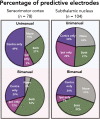Differential contribution of sensorimotor cortex and subthalamic nucleus to unimanual and bimanual hand movements
- PMID: 38124548
- PMCID: PMC10793582
- DOI: 10.1093/cercor/bhad492
Differential contribution of sensorimotor cortex and subthalamic nucleus to unimanual and bimanual hand movements
Abstract
Why does unilateral deep brain stimulation improve motor function bilaterally? To address this clinical observation, we collected parallel neural recordings from sensorimotor cortex (SMC) and the subthalamic nucleus (STN) during repetitive ipsilateral, contralateral, and bilateral hand movements in patients with Parkinson's disease. We used a cross-validated electrode-wise encoding model to map electromyography data to the neural signals. Electrodes in the STN encoded movement at a comparable level for both hands, whereas SMC electrodes displayed a strong contralateral bias. To examine representational overlap across the two hands, we trained the model with data from one condition (contralateral hand) and used the trained weights to predict neural activity for movements produced with the other hand (ipsilateral hand). Overall, between-hand generalization was poor, and this limitation was evident in both regions. A similar method was used to probe representational overlap across different task contexts (unimanual vs. bimanual). Task context was more important for the STN compared to the SMC indicating that neural activity in the STN showed greater divergence between the unimanual and bimanual conditions. These results indicate that SMC activity is strongly lateralized and relatively context-free, whereas the STN integrates contextual information with the ongoing behavior.
Keywords: DBS; ECoG; bmanual movement; ipsilateral; movement encoding.
© The Author(s) 2023. Published by Oxford University Press. All rights reserved. For permissions, please e-mail: journals.permission@oup.com.
Figures







References
-
- Abosch A, Hutchison WD, Saint-Cyr JA, Dostrovsky JO, Lozano AM. Movement-related neurons of the subthalamic nucleus in patients with Parkinson disease. J Neurosurg. 2002:97(5):1167–1172. - PubMed
-
- Alegre M, Alonso-Frech F, Rodríguez-Oroz MC, Guridi J, Zamarbide I, Valencia M, Manrique M, Obeso JA, Artieda J. Movement-related changes in oscillatory activity in the human subthalamic nucleus: ipsilateral vs. contralateral movements. Eur J Neurosci. 2005:22(9):2315–2324. - PubMed
-
- Alexander GE, Crutcher MD. Functional architecture of basal ganglia circuits: neural substrates of parallel processing. Trends Neurosci. 1990:13(7):266–271. - PubMed
-
- Alexander GE, DeLong MR, Strick PL. Parallel organization of functionally segregated circuits linking basal ganglia and cortex. Annu Rev Neurosci. 1986:9(1):357–381. - PubMed
-
- Benarroch EE. Subthalamic nucleus and its connections: anatomic substrate for the network effects of deep brain stimulation. Neurology. 2008:70(21):1991–1995. - PubMed
Publication types
MeSH terms
Grants and funding
LinkOut - more resources
Full Text Sources
Medical

